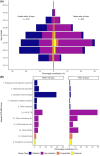Pregnancy-related mortality up to 1 year postpartum in sub-Saharan Africa: an analysis of verbal autopsy data from six countries
- PMID: 37469195
- PMCID: PMC10952650
- DOI: 10.1111/1471-0528.17606
Pregnancy-related mortality up to 1 year postpartum in sub-Saharan Africa: an analysis of verbal autopsy data from six countries
Abstract
Objective: To compare the causes of death for women who died during pregnancy and within the first 42 days postpartum with those of women who died between >42 days and within 1 year postpartum.
Design: Open population cohort (Health and Demographic Surveillance Systems).
Setting: Ten Health and Demographic Surveillance Systems (HDSS) in The Gambia, Kenya, Malawi, Tanzania, Ethiopia and South Africa.
Population: 2114 deaths which occurred within 1 year of the end of pregnancy where a verbal autopsy interview was conducted from 2000 to 2019.
Methods: InterVA5 and InSilicoVA verbal autopsy algorithms were used to attribute the most likely underlying cause of death, which were grouped according to adapted International Classification of Diseases-Maternal Mortality categories. Multinomial regression was used to compare differences in causes of deaths within 42 days versus 43-365 days postpartum adjusting for HDSS and time period (2000-2009 and 2010-2019).
Main outcome measures: Cause of death and the verbal autopsy Circumstances of Mortality Categories (COMCATs).
Results: Of 2114 deaths, 1212 deaths occurred within 42 days postpartum and 902 between 43 and 365 days postpartum. Compared with deaths within 42 days, deaths from HIV and TB, other infectious diseases, and non-communicable diseases constituted a significantly larger proportion of late pregnancy-related deaths beyond 42 days postpartum, and health system failures were important in the circumstances of those deaths. The contribution of HIV and TB to deaths beyond 42 days postpartum was greatest in Southern Africa. The causes of pregnancy-related mortality within and beyond 42 days postpartum did not change significantly between 2000-2009 and 2010-2019.
Conclusions: Cause of death data from the extended postpartum period are critical to inform prevention. The dominance of HIV and TB, other infectious and non-communicable diseases to (late) pregnancy-related mortality highlights the need for better integration of non-obstetric care with ante-, intra- and postpartum care in high-burden settings.
Keywords: causes of death; maternal health; pregnancy-related mortality; verbal autopsy.
© 2023 The Authors. BJOG: An International Journal of Obstetrics and Gynaecology published by John Wiley & Sons Ltd.
Conflict of interest statement
None declared.
Figures




Similar articles
-
Temporal changes in cause of death among adolescents and adults in six countries in eastern and southern Africa in 1995-2019: a multi-country surveillance study of verbal autopsy data.Lancet Glob Health. 2024 Aug;12(8):e1278-e1287. doi: 10.1016/S2214-109X(24)00171-2. Lancet Glob Health. 2024. PMID: 39030059 Free PMC article.
-
Tuberculosis and HIV are the leading causes of adult death in northwest Ethiopia: evidence from verbal autopsy data of Dabat health and demographic surveillance system, 2007-2013.Popul Health Metr. 2017 Jul 17;15(1):27. doi: 10.1186/s12963-017-0139-z. Popul Health Metr. 2017. PMID: 28716042 Free PMC article.
-
Direct maternal deaths attributable to HIV in the era of antiretroviral therapy: evidence from three population-based HIV cohorts with verbal autopsy.AIDS. 2020 Jul 15;34(9):1397-1405. doi: 10.1097/QAD.0000000000002552. AIDS. 2020. PMID: 32590436
-
Eliminating preventable HIV-related maternal mortality in sub-Saharan Africa: what do we need to know?J Acquir Immune Defic Syndr. 2014 Dec 1;67 Suppl 4(Suppl 4):S250-8. doi: 10.1097/QAI.0000000000000377. J Acquir Immune Defic Syndr. 2014. PMID: 25436825 Free PMC article. Review.
-
Health & Demographic Surveillance System Profile: Farafenni Health and Demographic Surveillance System in The Gambia.Int J Epidemiol. 2015 Jun;44(3):837-47. doi: 10.1093/ije/dyv049. Epub 2015 May 6. Int J Epidemiol. 2015. PMID: 25948661 Review.
Cited by
-
Trends, Projections, and Regional Disparities of Maternal Mortality in Africa (1990-2030): An ARIMA Forecasting Approach.Epidemiologia (Basel). 2023 Aug 29;4(3):322-351. doi: 10.3390/epidemiologia4030032. Epidemiologia (Basel). 2023. PMID: 37754279 Free PMC article.
-
Global and regional causes of maternal deaths 2009-20: a WHO systematic analysis.Lancet Glob Health. 2025 Apr;13(4):e626-e634. doi: 10.1016/S2214-109X(24)00560-6. Epub 2025 Mar 8. Lancet Glob Health. 2025. PMID: 40064189 Free PMC article.
-
Postpartum recovery after severe maternal morbidity in Kilifi, Kenya: a grounded theory of recovery trajectories beyond 42 days.BMJ Glob Health. 2024 Jun 25;9(6):e014821. doi: 10.1136/bmjgh-2023-014821. BMJ Glob Health. 2024. PMID: 38925665 Free PMC article.
References
-
- Sliwa K, Anthony J. Late maternal deaths: a neglected responsibility. Lancet. 2016;387(10033):2072–2073. - PubMed
-
- Hoj L, Stensballe J, Aaby P. Maternal mortality in Guinea‐Bissau: the use of verbal autopsy in a multi‐ethnic population. Int J Epidemiol. 1999;28(1):70–76. - PubMed
-
- Etard JF, Kodio B, Traoré S. Assessment of maternal mortality and late maternal mortality among a cohort of pregnant women in Bamako, Mali. BJOG. 1999;106(1):60–65. - PubMed
MeSH terms
Grants and funding
LinkOut - more resources
Full Text Sources
Medical

